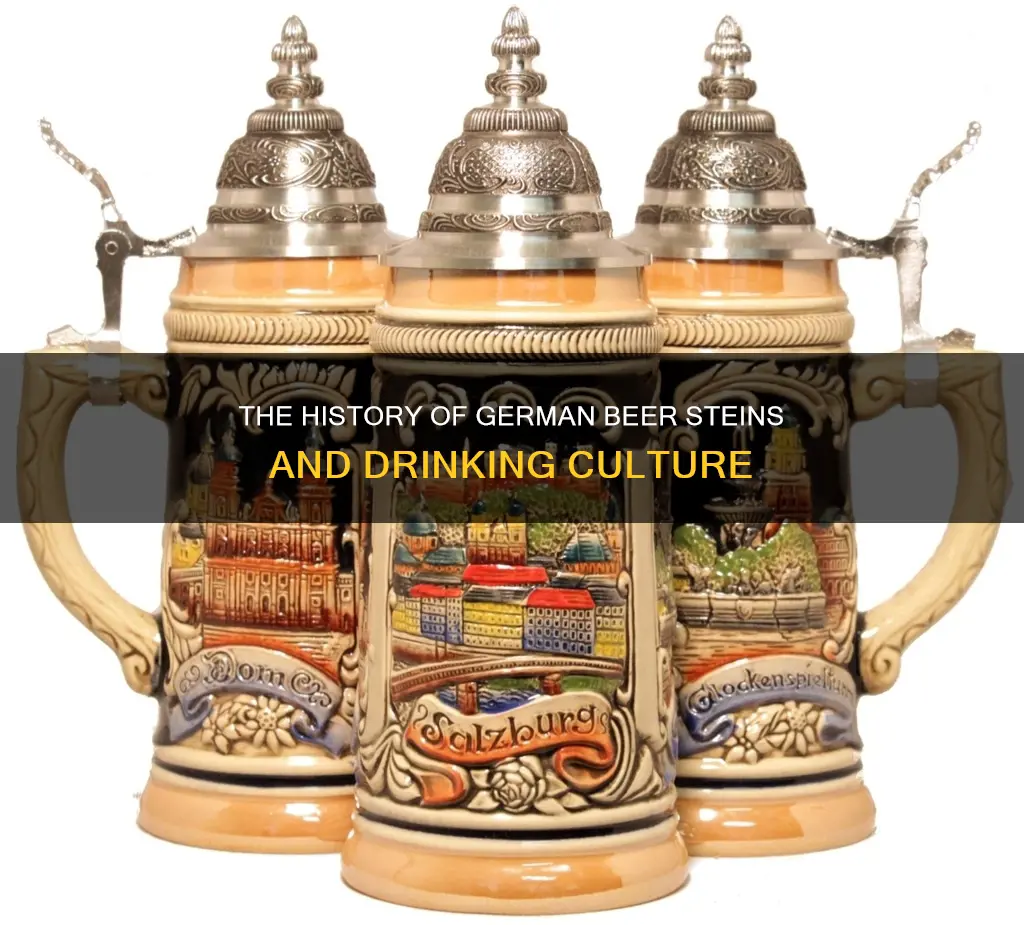
Beer steins, or simply steins, are traditional beer mugs with a hinged lid and a handle, usually made from stoneware. The word stein is borrowed from the German stein, which means stone, but also has regional meanings of beer mug and beer measure of 1 litre or 2 schoppen. The lids on beer steins were originally a sanitary measure, implemented to prevent insects and other contaminants from getting into the beer. The stein was also a status symbol for German families, often emblazoned with a household crest, shield or expression.
| Characteristics | Values |
|---|---|
| Origin | Germany |
| Purpose | Drinking beer |
| Other uses | Display, Collection, Souvenir, Status symbol |
| Materials | Stoneware, pewter, porcelain, silver, wood, crystal glass |
| Lid | Hinged, with a thumb-lever |
| Volume | Half-litre, full litre, or comparable historic sizes |
| Ornamentation | Shields, historical/allegorical/biblical scenes, Animal symbols |
What You'll Learn
- Beer steins were originally produced to improve sanitation and prevent the spread of the bubonic plague
- The word 'stein' is a shortened form of 'Steinzeugkrug', meaning stoneware jug or tankard in German
- Beer steins can be made from stoneware, pewter, porcelain, silver, wood or crystal glass
- The covered-container law was passed in Germany to prevent insects from contaminating food and drink
- Beer steins can be used to keep beer cool and prevent spillage

Beer steins were originally produced to improve sanitation and prevent the spread of the bubonic plague
The bubonic plague, or the Black Death, ravaged Europe in the 14th century, killing over 25 million people. In the aftermath of this devastation, sanitation and hygiene became a priority, and several laws were enacted in the early 16th century to improve public health. Germany, which had been facing frequent fly invasions, passed laws requiring that all food and beverage containers be covered to protect their contents from insects. This included beer steins, which were commonly used for drinking.
The introduction of the hinged lid with a thumblift on beer steins was a direct response to these sanitary measures. The lid could be easily opened and closed with one hand, making it a convenient and practical solution. These regulations also led to the improvement of earthenware, resulting in the creation of stoneware—a non-porous and chip-resistant material ideal for sanitary containers. The combination of stoneware and pewter lids created a durable and hygienic drinking vessel.
The enforcement of sanitary laws, including the covered-container law, had a significant impact on beer consumption and stein-making. Beerhouses, taverns, and city hall cellars became popular, and the average beer consumption increased to about two litres per day in many places. The improved sanitation and regulations regarding the quality and transport of beer resulted in a better-tasting beverage.
The beer stein, with its permanent pewter lid, became a status symbol for Germans. Adorned with household crests, shields, or expressions, it represented the value Germans placed on their food and drink. The steins were also decorated with artistic scenes, historical motifs, and allegorical designs, making them unique and desirable collector's items.
While the original purpose of the beer stein's lid may have been to keep insects out rather than specifically to prevent the bubonic plague, it played a crucial role in improving sanitation and public health during a time of great concern about the return of the deadly disease.
Cider and Beer: Mixing, Matching, and Drinking Safely
You may want to see also

The word 'stein' is a shortened form of 'Steinzeugkrug', meaning stoneware jug or tankard in German
The word "stein" is a shortened form of the German word "Steinzeugkrug", which means stoneware jug or tankard. In common usage, the word "stein" has come to refer to any beer container with a handle and a hinged lid, regardless of its material or size. While the word "tankard" would be more technically accurate, the two terms are often used interchangeably.
The English word "stein" was first recorded in 1855, borrowed from the German word "Stein", which primarily means "stone". However, it also has regional meanings of "beer mug" and "beer measure of 1 litre or 2 Schoppen". The word can be compared to the English "stean", meaning "stone or earthen vessel", and the Old English "stæne", meaning "pitcher" or "jug".
In standard German, the word "Stein" alone is no longer used to refer to a beverage container. Instead, words like "Krug", "Humpen", or "Seidel" are used, depending on the region. For example, in Bavaria and Austria, the term "Seidel" is commonly used for a half-litre beer container.
The use of a hinged lid on beer steins is believed to have originated as a sanitary measure to protect against insects, particularly during the summers in Central Europe when swarms of flies were prevalent. This measure was also thought to be a response to the Black Death, or bubonic plague, which ravaged Europe in the 14th century, killing over 25 million people. However, it is important to note that people at the time incorrectly believed the disease was spread through "miasmas", not flies.
The traditional area for beer stein production is the Kannenbäckerland in the Westerwald region of Germany, which has been crafting these vessels for centuries and is renowned among collectors as the original German beer stein producer. Beer steins can be made from a variety of materials, including stoneware, pewter, porcelain, silver, wood, crystal glass, and earthenware. The choice of material influences the production techniques and decorative possibilities, contributing to the unique character of each stein.
Beer After Brushing: What's the Dental Verdict?
You may want to see also

Beer steins can be made from stoneware, pewter, porcelain, silver, wood or crystal glass
Beer steins are traditionally made from stoneware, but they can also be made from pewter, porcelain, silver, wood, or crystal glass. Each material has its own advantages and disadvantages, as well as unique characteristics that make it a popular choice for beer stein production.
Stoneware is a type of ceramic made from special clay that is fired at extremely high temperatures, making it highly durable and long-lasting. It is known for its detailed decorations, which can include German coats of arms, hunting landscapes, and intricate ornamentation. Stoneware steins are also less expensive than other varieties of collector steins. However, they can be quite heavy, making them a less ideal choice for those seeking a lightweight option.
Pewter, an alloy made mainly of tin and copper, is another traditional material used for beer steins. It is long-lasting, easy to clean, and has a classic appearance that many collectors appreciate. Pewter steins are also one of the strongest types of beer steins, making them resistant to breaking.
Porcelain beer steins are prized for their intricate designs and rich artwork, often featuring hand-painted pictures of German customs and folklore. They are usually made from fine porcelain clay and come in white or ivory colours. Porcelain steins are also known for their excellent insulation properties, keeping beverages cold for extended periods.
Silver beer steins, though less common, were used by some of the wealthiest Germans in the past. They are typically decorative and may be considered a luxury item.
Wooden beer steins were also used historically, particularly in Scandinavian countries, where they perfected the method of making a wooden tankard with a wooden hinge. However, wooden steins from Germany during this period generally had pewter mountings and designs.
Crystal glass steins offer a modern take on the traditional beer stein, with a sleek and sophisticated appearance. They are made of high-quality glass, allowing for the clear viewing of intricate designs and artwork. However, glass steins are more fragile than other materials and may not withstand repeated use as well.
Beer and Thyroid Lobectomy: What You Need to Know
You may want to see also

The covered-container law was passed in Germany to prevent insects from contaminating food and drink
During the plague, it became evident that unsanitary conditions played a role in its spread, as 95% of those in filthy areas died compared to only 10% in clean surroundings. To prevent a recurrence of the plague, several principalities in what is now Germany passed laws requiring that all food and beverage containers be covered to protect against insects. This included the common mug, which was adapted to have a hinged lid with a thumb lift, allowing it to be used with one hand.
The covered-container law had a significant impact on drinking culture in Germany, leading to the development of the beer stein. A beer stein is a drinking vessel made of stoneware or other materials such as pewter, porcelain, or glass, and it typically has a hinged lid and a handle. The law requiring covered containers contributed to the popularity of the beer stein, as it could be easily used with one hand and provided protection against insects.
In addition to the covered-container law, other sanitary regulations were implemented, such as prohibiting pigpens from being adjacent to streets and requiring that old or diseased meat be labelled. Regulations were also put in place to improve the quality and transport of beer, leading to a significant improvement in its taste. As a result, beer drinking became increasingly popular in Germany, and the beer stein became a status symbol for many Germans.
Today, beer steins are still valued in Germany and are often decorated with nostalgic allusions to the country. They are commonly sold as souvenirs or collectibles and come in various sizes, typically holding half a litre or a full litre of beer. While modern beer mugs used in Germany are usually made of glass for hygienic reasons, the traditional beer stein with a hinged lid remains a beloved symbol of German drinking culture.
Liquid Diets and Beer: Is It Allowed?
You may want to see also

Beer steins can be used to keep beer cool and prevent spillage
Beer steins are traditional beer mugs that are often associated with Germany. They are typically made of stoneware, but can also be made of pewter, porcelain, silver, wood, or crystal glass. They usually come in sizes of half a litre or a full litre and are commonly decorated with allusions to Germany. The word "stein" is derived from the German word for "stone", but it also has regional meanings of "beer mug" and "beer measure of 1 litre or 2 Schoppen".
The history of the beer stein dates back to the late 1500s in Germany. At that time, strict laws enforcing sanitation on the ingredients, transport, and quality of beer were implemented to combat health issues associated with the Bubonic Plague. These laws led to an improvement in the taste of German beer, increasing the value and importance of the Beer Stein.
Beer steins are known for their hinged lids, which serve multiple purposes. One of the main functions of the lid is to keep the beer cool by preventing airflow from above. The lid also helps to retain the aroma of the beer by trapping volatile compounds and aromas, allowing drinkers to enjoy the full bouquet of the beer. Additionally, the lid can add an extra layer of protection, preventing insects and other contaminants from falling into the beer. This was especially important in outdoor settings or taverns, where debris and insects were more prevalent.
Another advantage of the lid is spillage prevention. Beer steins are often large and filled to the brim, so the lid reduces the risk of accidentally sloshing or spilling the beer while walking or in crowded environments. This feature was particularly useful during celebrations or when clinking glasses with others.
In addition to their practical purposes, beer steins also hold cultural and artistic value. They are considered a status symbol and a display piece for German families, often emblazoned with a household crest, shield, or expression. Beer steins are also collectible items, with traditional designs such as brewery emblems and Bavarian motifs being highly sought-after. The durability and unique features of beer steins, such as handles and texturing, make them a popular choice for drinking vessels, enhancing the overall beer-drinking experience.
Drinking Beer With Theraflu: A Risky Combination
You may want to see also
Frequently asked questions
Beer steins were originally produced to combat health issues that triggered the Bubonic Plague.
Beer steins can be made from stoneware, pewter, porcelain, silver, wood or crystal glass.
The lid was originally conceived as a sanitary measure to keep insects and other contaminants out of the beer.







